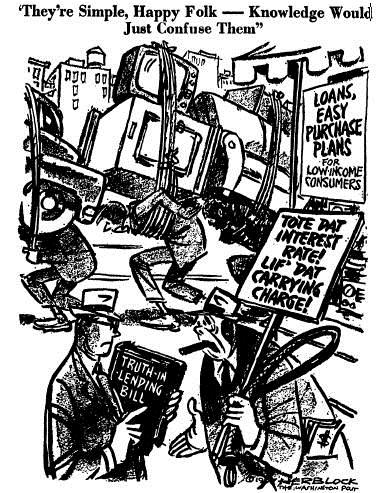Banking and Credit
Since the Great Depression, Congress has passed a series of laws to preserve stability in the banking and credit industries, protect consumers from unfair and deceptive practices and make affordable credit available to middle class and low-income families and small businesses. Beginning in the 1980s, the deregulation of financial institutions has fed speculative booms and devastating busts. Privatization of low-cost government credit for student loans and mortgages and weaker consumer protections has driven up the cost of credit and put consumers at risk.
Commentary
Information is power… and that’s the problem
Why #OccupyWallStreet?
Cry Wolf Quotes
The roots of this crisis go back to the Carter administration. That was when government officials, egged on by left-wing activists, began accusing mortgage lenders of racism and "redlining" because urban blacks were being denied mortgages at a higher rate than suburban whites. The pressure to make more loans to minorities (read: to borrowers with weak credit histories) became relentless. Congress passed the Community Reinvestment Act, empowering regulators to punish banks that failed to "meet the credit needs" of "low-income, minority, and distressed neighborhoods." Lenders responded by loosening their underwriting standards and making increasingly shoddy loans.
[The bill would] have a dramatic impact on the ability of consumers, small businesses, students, and others to get credit at a time when our economy can least afford such constraints.
They say, ‘Well, this is a failure of the markets. Oh, this is about greed on Wall Street.’… the problem here is government intervention in the free markets. 1995, when Bill Clinton decided to tell, you know, [then-Treasury Secretary] Robert Rubin to rewrite the rules that govern the Community Reinvestment Act and push all these institutions to lend to minority communities, many were very risky loans. That was a noble idea, perhaps, but that certainly wasn't following free-market principles. This big pressure on institutions to dole out money and these risky loans started this whole ball rolling at Fannie and Freddie.
The subprime mortgage market, which makes funds available to borrowers with impaired credit or little or no credit history, offers a good example of competition at work…To the contrary, it was lenders in the control group that refocused their efforts in line with the mid-1990s boom in lending in low-income neighborhoods. In fact, lending in low-income neighborhoods grew faster than other types of lending at institutions not covered by CRA, whereas low-income lending grew at the same rate as other types of lending activity for CRA-covered lenders. As a group, lenders not covered by CRA devoted a growing proportion of their home-purchase lending to low-income communities, with the community lending share of their loan portfolios rising from 11 percent in 1993 to 14.3 percent in 1997. In contrast, CRA-covered lenders, as a group, devoted about the same proportion of their home-purchase loans to low-income neighborhoods in 1997 as they did in 1993. In both years, their community-lending share was about 11.5 percent. Even though those institutions were subject to CRA, their lending in low-income communities grew no faster than other lending. Those results would not be expected if CRA were the impetus for increases in lending in low-income neighborhoods. The data, however, are consistent with deregulation and technological advances leading to lower information costs and increased competition in the mortgage market. Independent mortgage companies tend to have more leeway to specialize in relatively risky lending than their more conservative and more heavily regulated counterparts in the banking industry. It is not surprising, then, that independent companies took the lead in focusing on lending activity in the riskier segments of the mortgage market… The inescapable conclusion is that progress predicated on technology, financial innovation, and competition—not CRA—has broadened the U.S. financial services marketplace.
Related Laws and Rules
Evidence
-
Banking Lobby's Warnings About CARD Act Disproven
What happened after credit card reform bill passed Congress in 2009 (it worked).
-
The Successes of the CARD Act
The Consumer Financial Protection Bureau describes exactly what the act did and what the effects were one year later.
Backgrounders & Briefs
A Timeline of the CARD Act
An interactive timeline of credit card reform.
Resources
The National Community Reinvestment Coalition works against unfair lending and banking practices, particularly those targeted towards low and middle income families.



